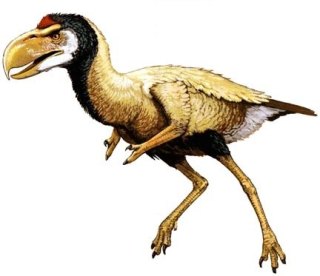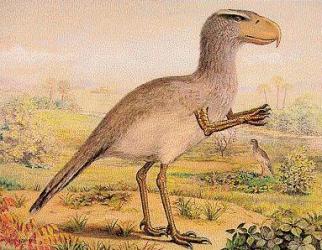Ice Age Terror Birds?
Posted by: Loren Coleman on June 19th, 2008
Yes, another flightless fossil bird blog entry…

Darren Naish has published a new analysis on terror birds, entitling this one, “Raven, the claw-handed bird, last of the phorusrhacids.”

I won’t even try to summarize the amazing things he has written about in his intellectually stimulating posting. Instead, I’ll share three of his remarkable images to encourage you to go look over there and read, firsthand, his answers to the questions: “Was Titanis really alive in the Late Pleistocene?” and “Did Titanis really manage to hang on this late?”

About Loren Coleman
Loren Coleman is one of the world’s leading cryptozoologists, some say “the” leading living cryptozoologist. Certainly, he is acknowledged as the current living American researcher and writer who has most popularized cryptozoology in the late 20th and early 21st centuries.
Starting his fieldwork and investigations in 1960, after traveling and trekking extensively in pursuit of cryptozoological mysteries, Coleman began writing to share his experiences in 1969. An honorary member of Ivan T. Sanderson’s Society for the Investigation of the Unexplained in the 1970s, Coleman has been bestowed with similar honorary memberships of the North Idaho College Cryptozoology Club in 1983, and in subsequent years, that of the British Columbia Scientific Cryptozoology Club, CryptoSafari International, and other international organizations. He was also a Life Member and Benefactor of the International Society of Cryptozoology (now-defunct).
Loren Coleman’s daily blog, as a member of the Cryptomundo Team, served as an ongoing avenue of communication for the ever-growing body of cryptozoo news from 2005 through 2013. He returned as an infrequent contributor beginning Halloween week of 2015.
Coleman is the founder in 2003, and current director of the International Cryptozoology Museum in Portland, Maine.










Well, I gave it a try, but unfortunately the writing style of this PHD is clearly intended fo his peers, not dumb people like me.
However, there’s something that intrigues me; he contends that this extinct animal couldn’t have created the legends of Raven among some of the native people in British Columbia, because so far we can only assume this animal lived in central Florida. Now, I’ve never understood why scientists believe human migrations are only unidirectional—what, can’t people change their mind and turn around?? were they being persecuted by their mother-in-laws?—or that the only way humans could have come to the New World is EXCLUSIVELY following an North-South approach, while there are plenty theories that speculate humans could have come from the Polinesian Islands too. Right now we have evidence of human settlements in South America and Mexico that are older than the evidence found in North America, so why are we still so inclined to think people colonized the south AFTER they crossed the Northern lands of the continent first?
Do I think this Terror Bird is the source of the legends behind Raven? Not necessarily, but the evidence put forth to dispute it disturbs me a little.
Another thing that bothers me is the second illustration. Am I the only one who thinks the legs of that huge chicken are just too slim to support its body? The first illustration is better, although the legs ressemble that of an ostrich, which maybe would work although ostriches don’t have to carry that humongous beak.
You have to keep in mind that even large birds like the ostrich have also still very thin legs compared to their size. A big beak adds only some pounds to the total weight, and if we are already well over 100 pounds, that doesn´t change much. Furthermore the fossils show that their legs were actually comparably thin. In contrast, there are some very massive extinct birds like Aepyornis, Dromornis or the heavy-footed moa Megalapterxy, which had really very thick and robust limbs, but none of them was probably a fast runner, but more a comparable slow browser.
Thanks for the info Sordes. So, how fast do paleontologists think these parakeets from Hades were able to run? 🙂
Very interesting! Thanks for the pics and the link, Mr. C. I have a pretty hard time going along with the idea that the indigenous people in the Pacific North West Coast region based their stories of Raven on creatures like this. For one thing, when one looks at the artistic depictions of Raven from either Kwakiutl or Haida traditions, they resemble ravens much more than they do something like Titanis. The often oversized bills in these depictions are, in my view, simply an exaggeration of a prominent feature, which figures into the stylized nature of the art. Ravens do, indeed, have very stout bills. Moreover, Corvus Corax is possibly the most intelligent of all avians, and physically speaking it is a very large bird. In fact, they are the largest birds in the order Passeriformes. And they can be fierce. I have observed an adult raven harrying a large red tailed hawk by actually ramming into it in flight; and even though these birds were more than 30 feet above me, I could hear the sound of the impact when they collided. Ravens are very opportunistic feeders, and have earned a dark reputation from millennia of feeding on human carrion on battlefields around the world. Ravens have been known to fly toward the sound of gunfire, rather than away from it, because they know they’re likely to find a meal in that direction. I think Corvus Corax is a remarkable enough bird to have been the sole source of these (often wonderful) stories in the Kwakiutl and Haida traditions.
this creature would be great as a pet